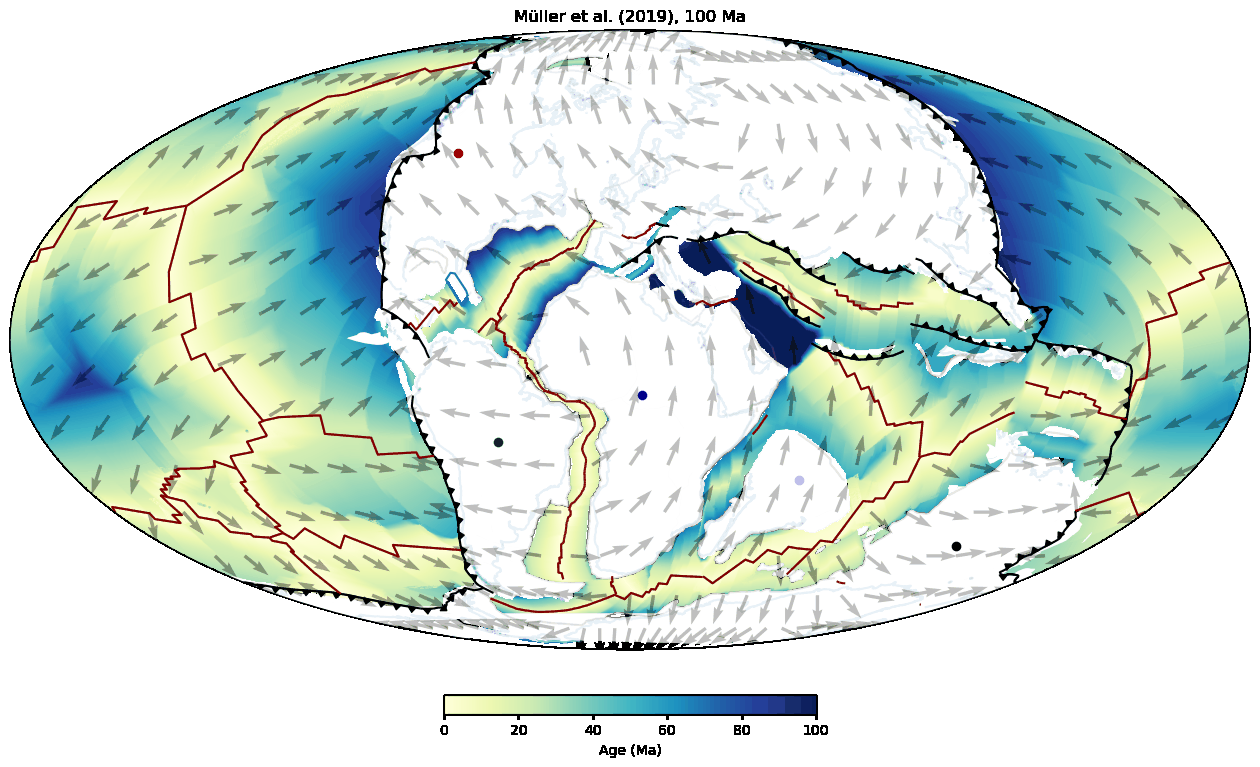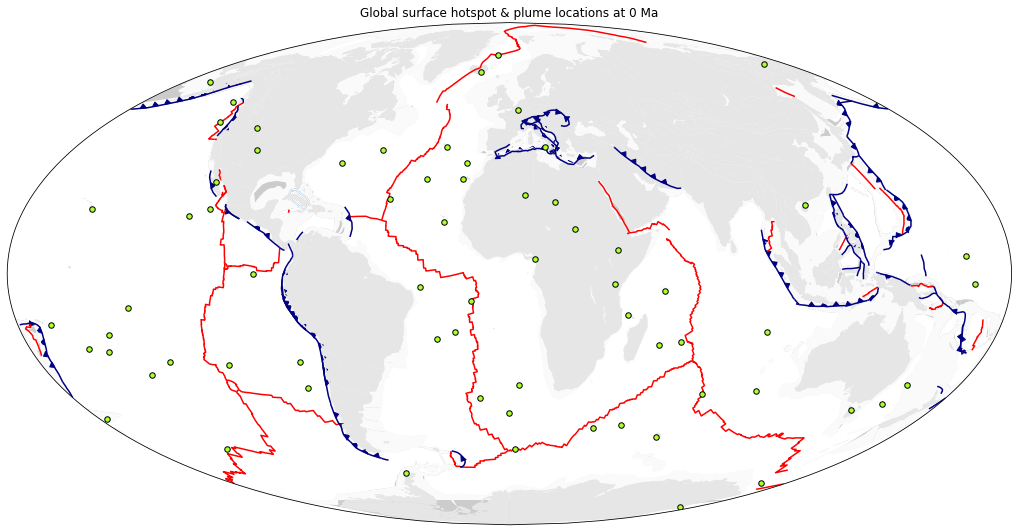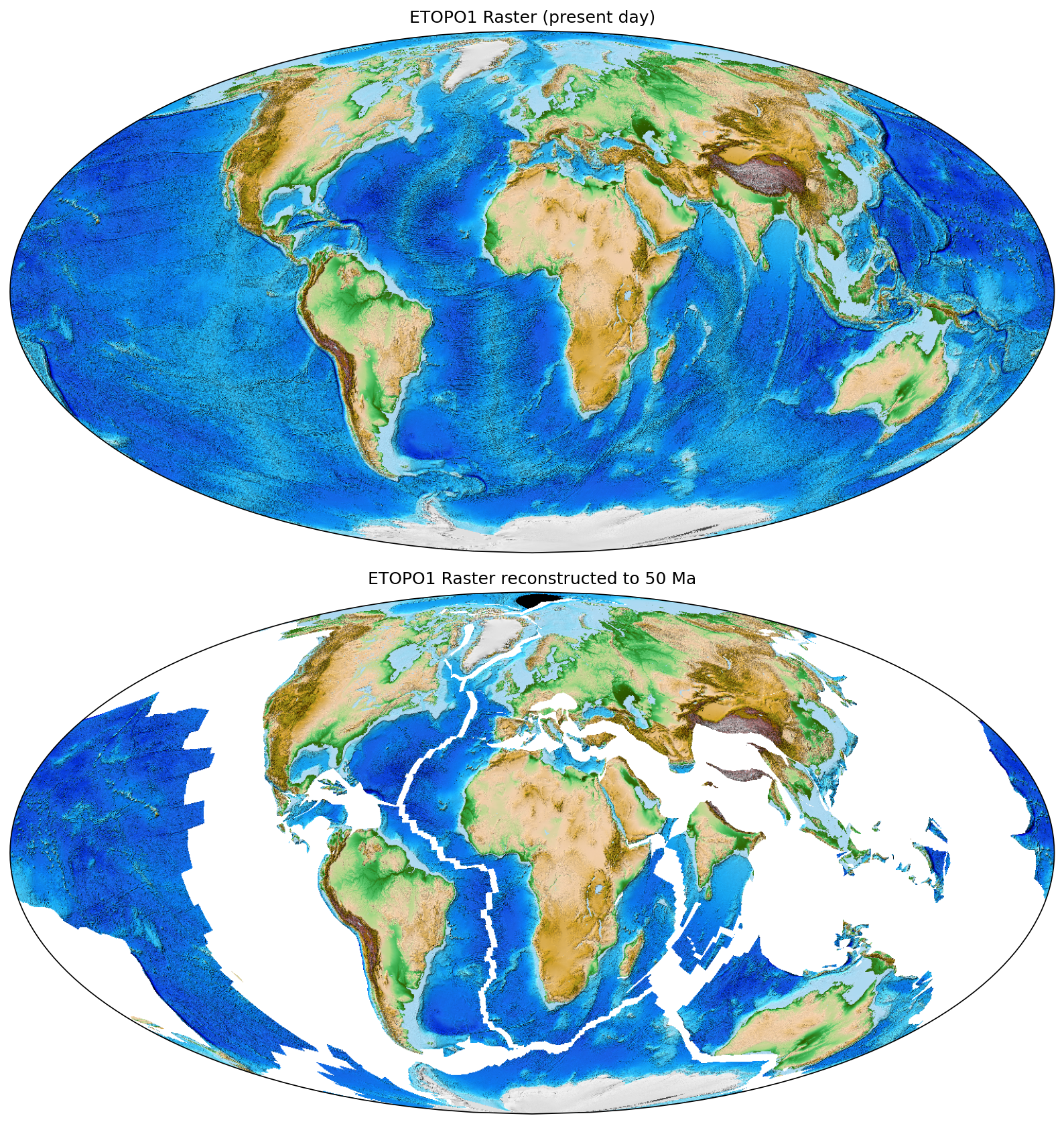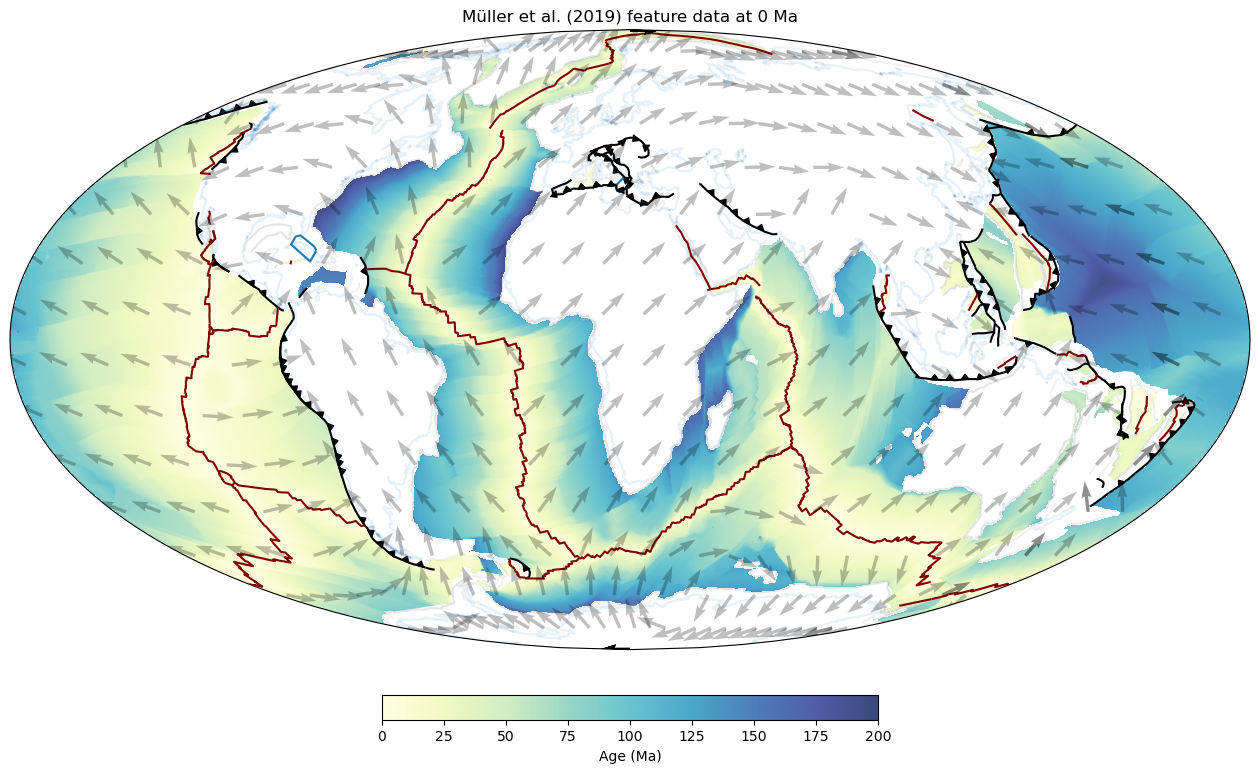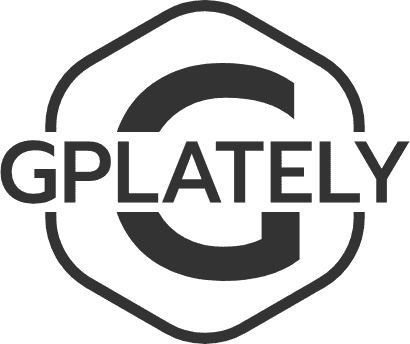
GPlately was created to accelerate spatio-temporal data analysis leveraging pyGPlates and PlateTectonicTools within a simplified Python interface. This object-oriented package enables the reconstruction of data through deep geologic time (points, lines, polygons, and rasters), the interrogation of plate kinematic information (plate velocities, rates of subduction and seafloor spreading), the rapid comparison between multiple plate motion models, and the plotting of reconstructed output data on maps. All tools are designed to be parallel-safe to accelerate spatio-temporal analysis over multiple CPU processors.
GPlately requires a working installation of pyGPlates, which is freely available at https://www.gplates.org/download. All major system architectures (e.g. Linux, MacOS, Windows) are supported and installation instructions are well documented. Sample data is also available from EarthByte servers, which includes rasters, seafloor age grids, rotation files, and more to get started with plate reconstructions.
Mather, B.R., Müller, R.D., Zahirovic, S., Cannon, J., Chin, M., Ilano, L., Wright, N.M., Alfonso, C., Williams, S., Tetley, M., Merdith, A. (2023) Deep time spatio-temporal data analysis using pyGPlates with PlateTectonicTools and GPlately. Geoscience Data Journal, 1–8. Available from: https://doi.org/10.1002/gdj3.185
@article{Mather2023,
author = {Mather, Ben R. and Müller, R. Dietmar and Zahirovic, Sabin and Cannon, John and Chin, Michael and Ilano, Lauren and Wright, Nicky M. and Alfonso, Christopher and Williams, Simon and Tetley, Michael and Merdith, Andrew},
title = {Deep time spatio-temporal data analysis using pyGPlates with PlateTectonicTools and GPlately},
year = {2023},
journal = {Geoscience Data Journal},
pages = {1-8},
keywords = {geospatial, plate reconstructions, pyGPlates, python, tectonics},
doi = {https://doi.org/10.1002/gdj3.185},
url = {https://rmets.onlinelibrary.wiley.com/doi/abs/10.1002/gdj3.185},
eprint = {https://rmets.onlinelibrary.wiley.com/doi/pdf/10.1002/gdj3.185},
}- pyGPlates
- plate-model-manager >= 1.2.0
- Shapely
- NumPy > 1.16
- SciPy > 1.0
- Matplotlib
- Cartopy (for mapping)
- Shapely
- Pooch
- GeoPandas
- netCDF4
You can install the latest stable public release of GPlately and all of its dependencies using conda.
This is the preferred method to install GPlately which downloads binaries from the conda-forge channel.
conda install -c conda-forge gplatelyWe recommend creating a new conda environment inside which to install GPlately. This avoids any potential conflicts in your base Python environment. In the example below we create a new environment called "my-env":
conda create -n my-env
conda activate my-env
conda install -c conda-forge gplatelymy-env needs to be activated whenever you use GPlately: i.e. conda activate my-env.
Alternatively, you can install the latest stable public release of GPlately using the pip package manager.
pip install gplatelyor from this GitHub repository:
pip install git+https://github.com/GPlates/gplately.gitFirst-time installation: To install the latest version of GPlately from a specific repository branch (e.g. master), copy the following commands into your terminal:
cd /path/to/desired/directory #Change your command directory to where you'd like to clone GPlately
git clone https://github.com/GPlates/gplately.git
cd gplately # navigate within the gplately folder
git checkout master # or the name of whichever branch you need
git pull # fetch all recent changes from this branch
pip install .Update installation from cloned repo: To update your installation of GPlately by fetching the latest pushes from a specific repository branch (e.g. master), copy the following commands into your terminal:
cd /path/to/gplately/directory #Should be where gplately is cloned - must end in /.../gplately
git checkout master # or the name of whichever branch you need
git pull # fetch all recent changes from this branch
pip install .GPlately uses objects to accomplish a variety of common tasks. The common objects include:
DataServer- download rotation files and topology features from plate models on EarthByte's webDAV serverPlateModelManager- download and manage the plate reconstruction model filesPlateReconstruction- reconstruct features, tesselate mid ocean ridges, subduction zonesPoints- partition points onto plates, rotate back through timeRaster- read in NetCDF grids, interpolation, resamplingPlotTopologies- one stop shop for plotting ridges, trenches, subduction teeth
GPlately's DataServer object can be used to download:
- rotation models
- topology features
- static polygons
- coastlines
- continents
- continent-ocean boundaries
- age grids and rasters
- geological feature data
from assorted plate reconstruction models. These files are needed to construct most of GPlately's objects. For example,
we can download a rotation model, a set of topology features and some static polygons from the Müller et al. 2019
global Mesozoic–Cenozoic deforming plate motion model.
gDownload = gplately.DataServer("Muller2019")
rotation_model, topology_features, static_polygons = gDownload.get_plate_reconstruction_files()... was designed as a substitute of DataServer object. The PlateModelManager object can be used to download and manage the plate reconstruction model files.
pm_manager = PlateModelManager()
model = pm_manager.get_model("Muller2019")
model.set_data_dir("plate-model-repo")
recon_model = PlateReconstruction(
model.get_rotation_model(),
topology_features=model.get_layer("Topologies"),
static_polygons=model.get_layer("StaticPolygons"),
)
gplot = PlotTopologies(
recon_model,
coastlines=model.get_layer("Coastlines"),
COBs=model.get_layer("COBs"),
time=55,
)
... contains methods to reconstruct the positions of present-day feature data back through geological time. You can also use
it to calculate plate model data like topological plate velocities, or total trench and ridge lengths per Ma! You can create
the object by passing a rotation model, a set of topology features and some static polygons:
model = gplately.PlateReconstruction(rotation_model, topology_features, static_polygons)Launch the Plate Reconstruction notebook to see more.
... can be used to reconstruct the positions of geological point features and calculate their underlying plate velocities through geological time.
pt_lon = np.array([-107.662152, -58.082792, 17.483189, 133.674590, 80.412876])
pt_lat = np.array([48.797807, -12.654857, 11.884395, -26.415630, 31.368509])
# Call the Points object: pass the PlateReconstruction object, and the latitudes and longitudes of the seed points!
gpts = gplately.Points(model, pt_lon, pt_lat)...can be used to read, resample and resize assorted raster data like netCDF4 seafloor age grids, continental grids and ETOPO
relief rasters. You can also reconstruct raster data back through geological time!
etopo = gdownload.get_raster("ETOPO1_tif")
raster = gplately.Raster(
model,
data=etopo,
time=0,
origin="upper",
)
white_rgb = (255, 255, 255) # RGB code for white, to fill gaps in output
reconstructed = raster.reconstruct(
time=50,
fill_value=white_rgb,
threads=4,
)Below is a plot of the ETOPO1 global relief raster at present day, and reconstructed to 50Ma:
... can be used to visualise reconstructed feature geometries through time. To call the object, pass a set of continents,
coastlines and COBs (either as file paths or as <pyGPlates.FeatureCollection> objects), as well as a PlateReconstruction
object, and a reconstruction time.
coastlines, continents, COBs = gDownload.get_topology_geometries()
time = 50 #Ma
gPlot = gplately.plot.PlotTopologies(model, time, coastlines, continents, COBs)Below are some continents, coastlines, COBs, ridges and transforms, trenches, subduction teeth and
seafloor age grids plotted using PlotTopologies!
To see GPlately in action, launch a Jupyter Notebook environment and check out the sample notebooks:
- 01 - Getting Started: A brief overview of how to initialise GPlately's main objects
- 02 - Plate Reconstructions: Setting up a
PlateReconstructionobject, reconstructing geological data through time - 03 - Working with Points: Setting up a
Pointsobject, reconstructing seed point locations through time with. This notebook uses point data from the Paleobiology Database (PBDB). - 04 - Velocity Basics: Calculating plate velocities, plotting velocity vector fields
- 05 - Working with Feature Geometries: Processing and plotting assorted polyline, polygon and point data from GPlates 2.3's sample data sets
- 06 - Rasters: Reading, resizing, resampling raster data, and linearly interpolating point data onto raster data
- 07 - Plate Tectonic Stats: Using PlateTectonicTools to calculate and plot subduction zone and ridge data (convergence/spreading velocities, subduction angles, subduction zone and ridge lengths, crustal surface areas produced and subducted etc.)
- 08 - Predicting Slab Flux: Predicting the average slab dip angle of subducting oceanic lithosphere.
- 09 - Motion Paths and Flowlines: Using pyGPlates to create motion paths and flowines of points on a tectonic plate to illustrate the plate's trajectory through geological time.
- 10 - SeafloorGrid: Defines the parameters needed to set up a
SeafloorGridobject, and demonstrates how to produce age and spreading rate grids from a set of plate reconstruction model files.
Documentation of GPlately's objects and methods can be found here!
GPlately comes with a suite of useful command line tools. These tools are designed as GPlately subcommands. Run gplately -h to show the list of tools.
-
combine
Combine multiple feature collections into one. Run
gplately combine -hfor details. -
filter
Filter feature collection by various criteria. See scripts/test_feature_filter.sh for usage examples. Run
gplately filter -hfor details. -
agegrid (ag)
Create age grids for a plate model. Run
gplately agegrid -hfor details. -
fix_crossovers
Loads one or more input rotation files, fixes any crossovers and saves the rotations to output rotation files. Run
gplately fix_crossovers -hfor details. -
remove_rotations
Remove one or more plate IDs from a rotation model (consisting of one or more rotation files). Run
gplately remove_rotations -hfor details. -
cleanup_topologies
Remove any regular features not referenced by topological features. Run
gplately cleanup_topologies -hfor details. -
convert_xy_to_gplates
Converts geometry in one or more input ascii files (such as '.xy' files) to output files suitable for loading into GPlates. Run
gplately convert_xy_to_gplates -hfor details. -
diagnose_rotations
Diagnose one or more rotation files to check for inconsistencies. Run
gplately diagnose_rotations -hfor details. -
resolve_topologies
Resolve topological plate polygons (and deforming networks) and saves (to separate files) the resolved topologies, and their boundary sections as subduction zones, mid-ocean ridges (ridge/transform) and others (not subduction zones or mid-ocean ridges). Run
gplately resolve_topologies -hfor details. -
rotation_tools
Calculate stage rotations between consecutive finite rotations in plate pairs. Run
gplately rotation_tools -hfor details. -
separate_ridge_transform_segments
Split the geometries of isochrons and mid-ocean ridges into ridge and transform segments. Run
gplately separate_ridge_transform_segments -hfor details. -
subduction_convergence
Find the convergence rates along trenches (subduction zones) over time. Run
gplately subduction_convergence -hfor details. -
gpmdb
Retrieve paleomagnetic data from https://www.gpmdb.net, create GPlates-compatible VGP features and save the VGP features in a .gpmlz file. Run
gplately gpmdb -hfor details.



